Pages of Progress: The Toa Payoh Public Library
Over the last five decades, the library has developed to keep pace with the changing needs of the residents of Toa Payoh.
By Rebecca Tan

A little over 50 years have passed since Toa Payoh Public Library opened its doors in 1974. Today, the building has become a landmark in the area. Built in what was then a young and growing town, the library is the second branch of the National Library after the first in Queenstown in 1970.1 With its distinctive facade and location in the heart of Toa Payoh, the library has served generations of patrons.
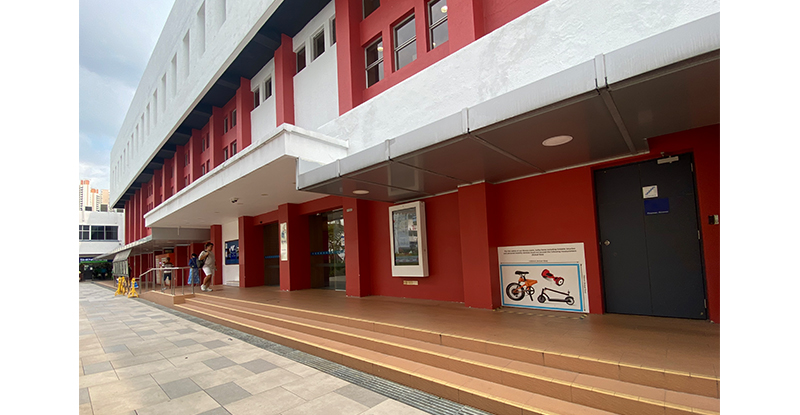
The Right Place
Much work went into selecting the site of the library. Chan Thye Seng, a National Library officer and chairman of the Toa Payoh Branch Library building committee, noted in his oral history interview: “I remember we went out to the site and that time, the [Toa Payoh] town centre was just like a desert… probably there were some residential flats there but not all those restaurants, community centres, churches, they were all non-existent at that time. And I remember we had to use a minivan to drive in. There was not even a proper macadamised road to reach the site.”2
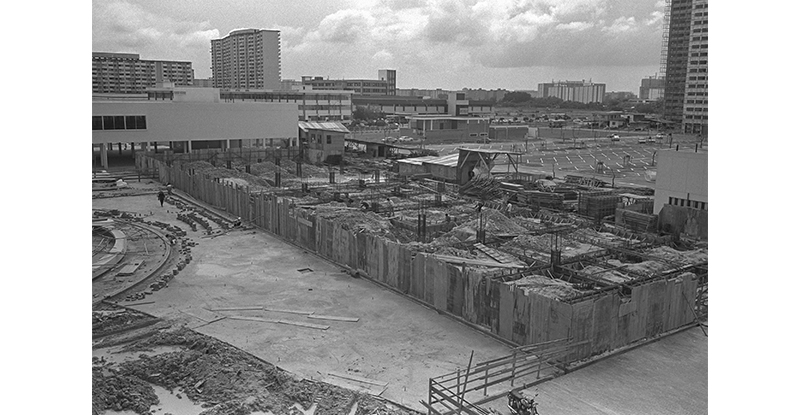
Tan Beng Kiat, the Public Works Department chief of building works, showed the committee the plan of Toa Payoh town centre. “Restaurants, theatres, and there [were] two sides, one facing the fountain and the other side where it’s currently the famous Chinese restaurant or cinema or McDonald’s, and we were given either one of these,” said Chan. Upon Tan’s advice, the committee chose the side that “faces the fountain across the main road, which is a more commanding side”. Chan noted that the topmost floor of the library could serve as the viewing tower for royalty or foreign VIPs, as they would have a good view of the entire town.3
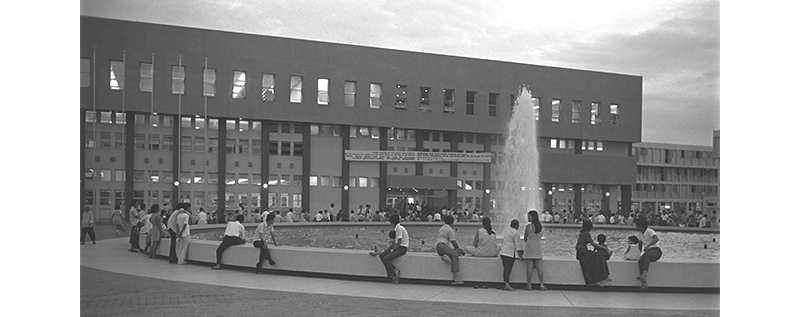
The committee also planned the new and existing facilities that the library would house. Interestingly, in addition to operating as a public library for patrons, the Toa Payoh Library was envisaged as the headquarters of the Library Extension Services comprising the mobile library service and part-time branch libraries. Part of the space would be set aside to keep inventory for the mobile library.4 “The aim of the mobile library service was to take the books out to the schools and the community so that children could borrow books from the mobile libraries,” said Amarjeet Gill, who headed Toa Payoh Library from 1993 to 1994.5
 An aerial view of Toa Payoh Library, 1970s. Collection of the National Library Singapore.
An aerial view of Toa Payoh Library, 1970s. Collection of the National Library Singapore.SEAP Games Secretariat
Before it opened, the library building served as the secretariat of the 7th South East Asian Peninsular (SEAP) Games, held for the first time in Singapore in September 1973.6
While the government had already accepted a tender valued at $1,233,989 in early 1973 for the building of Toa Payoh Branch Library, work was halted for one month for the SEAP games. Chan explained: “It was probably the largest non-residential building in the area, bigger than any restaurant or cinema at that time. There were hardly any buildings around except for the flats where the sportsmen were housed.”7
After the last of the 1,500 SEAP Games competitors left on 11 September 1973, the only activity that remained in the Games Village was at the secretariat building. It functioned until 15 September while officials sorted out “the aftermath of the seven-day event”.8
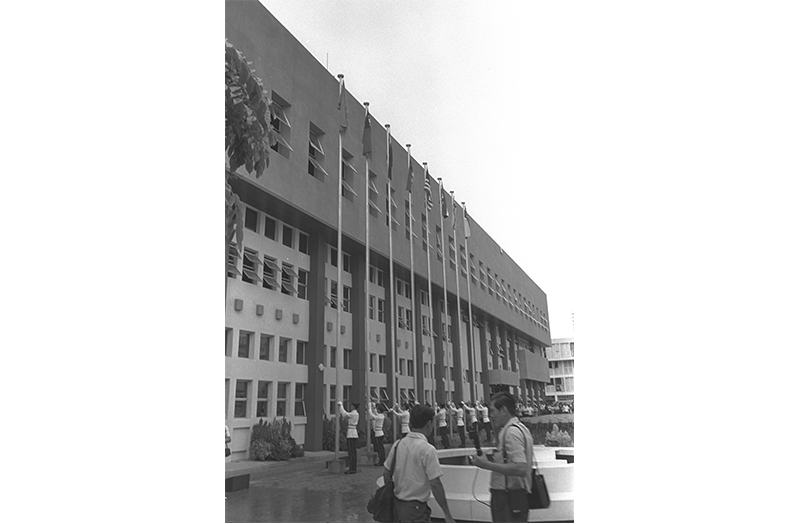
A New Page in History
The Toa Payoh Branch Library officially opened on 7 February 1974, with Cheong Kwai Liew as its first head.9 The opening ceremony included a lion dance and the unveiling of a plaque (which is still located at the entrance of the library today). In the invite that was sent out was a bookmark with the text, “There’s a library in your midst. Spread the news!”10 The festivities continued after the opening with programmes such as music performances, choral readings, film shows, a musical night and a magic show.11

Although Minister for Culture Jek Yeun Thong was scheduled to open the library, he was unable to attend and Haji Sha’ari Tadin, senior parliamentary secretary for the Ministry of Culture, delivered Jek’s speech on the minister’s behalf.
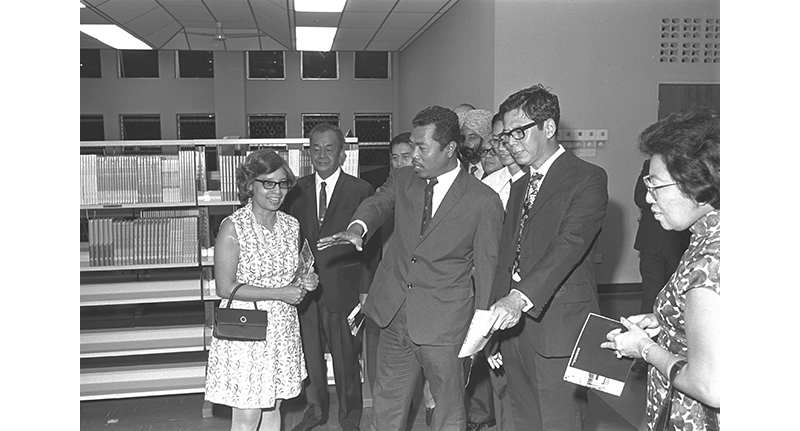
“The completion of the Toa Payoh Branch Library marks yet another stage in the development of the [National] Library’s facilities,” the speech read. “It will not only serve the reading requirements of the people of Toa Payoh, but will also serve as the headquarters of other services such as the popular mobile service as well as service to part-time branches, and to residents’ associations, social welfare homes, clubs and other institutions and associations.” It was Jek’s hope that the library would be an “incentive for all to renew their acquaintance with books and thus broaden their horizons and knowledge”.12

The library proved to be very popular with residents, especially children. A New Nation article from 1974 reported that about three-quarters of its total membership consisted of children, and in March 1974, its 9,744 child members borrowed a total of 53,950 books. The article noted that this figure was “much higher than comparative figures from the Central Library and the older Queenstown branch”.13
Interestingly, studying was not allowed in the library back then. The library published a brochure titled “Study Rooms in Community Centres Near the Toa Payoh Branch Library”. It noted that the library’s main objective “is to serve members of the public, including students, who wish to borrow books or consult library materials. It is not equipped to serve those who wish to use the premises for studying their own books or notes”.14 (In 2003, the National Library Board “relented on its ‘no studying’ policy”.)15

The popularity of the library can be seen in the fact that it increased the seating capacity of the adult and young people’s reading room from 180 to 220, and extended its operating hours from 50 to 63 hours the same year it opened. Two years later, in 1976, the library purchased a hundred more chairs.16 (Today, the library opens 77 hours per week from 10 am to 9 pm Monday through Sunday.)
In 1984, Toa Payoh Library celebrated its 10th anniversary with a stamp exhibition, a book display and a film show in its lecture hall.17 Programmes for its 20th anniversary in 1994 included an exhibition about Toa Payoh town as well as prizes and souvenirs sponsored by Philips Singapore, which had a big factory in the area.18 Gill, the branch head at the time, recalled: “We tried to make it as much a community event as we could. The library staff organised programmes and storytelling contests, put up posters, offered bookmarks and badges, and even designed a 20th anniversary celebration logo for the publicity materials. Even the McDonald’s located near the library sponsored breakfast meals for patrons who borrowed a certain number of books.” She said: “I think the staff were excited because when we did events, we just made do with what we had. This time, we had funding on a larger scale to do more than the usual things.”19
New Again
Over time, the Toa Payoh Library began to add new facilities. Air-conditioning was installed in 1982.20 A lift was subsequently added in 1985. “I will be able to use the books in the reference room, the audio-visual, and the microfilm reader. It will also be easier for me to attend talks at the lecture hall on the second floor,” said Chee Yuan Cheow, a wheelchair user who had requested the lift. The $77,000 lift became operational in December 1985.
Chee was very grateful to the library. “Previously, the library staff had to go up and down the stairs to bring me the catalogue drawers. And after I had selected the book, they had to go back to look for them. Now, I can get the books myself,” he said.21
On 1 September 1995, the National Library became a statutory board – the National Library Board (NLB) – and all branch libraries were renamed community libraries and branch heads became known as managers.22 To keep up with the times, Toa Payoh Community Library underwent a major revamp in 1998 and reopened the following year. Hajbee Abu Bakar, who was the library manager from 1994 to 2000, noted that the library needed “more than a few computers and television sets to keep up with the quality of services offered at newer libraries like the Cheng San community library”. These were used by patrons to access the library’s digital content and surf the Internet.23
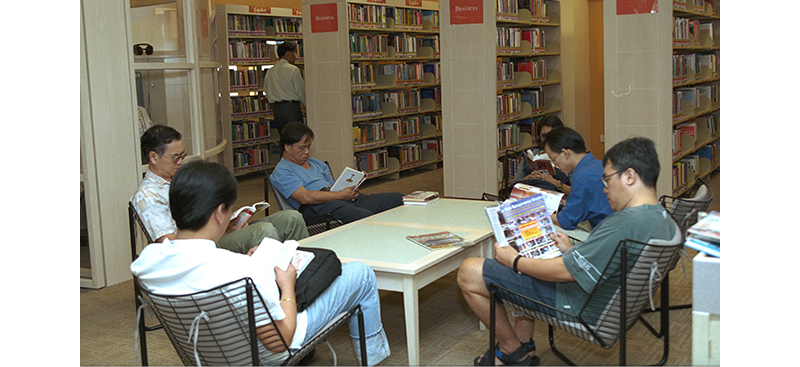
During peak hours and on weekends, the average queuing time for patrons was 30 minutes to an hour as library staff manually handled the borrowing and returning of books. The introduction of self-check counters was anticipated to reduce the waiting time to no more than 15 minutes.24
As part of the $3-million makeover, services and facilities for different age groups were refreshed, and technological innovations like multimedia stations were implemented. A new service was ONE Learning Place, an information technology training centre on the third floor. It provided information literacy programmes and internet classes for students and adults. A Senior Citizens’ Corner was also created – with comfortable sofas and chairs, large-print collections and a multimedia station – for elderly patrons to read, meet and interact with friends.25
“We have quite a number of senior citizens at this branch,” noted Hajbee. “We thought it would be a good idea to set aside a corner for them where they can do their reading quietly.” “There is really no age limit to our library users,” said Ngian Lek Choh, director of Public Library Services. “A large group of our users are children, teenagers and young adults, and now we want to encourage more older people to come.”26
The Children’s Section was refreshed with a “Treasure Island” theme and ark-shaped shelves. Other new services included borrowers’ enquiry terminals for patrons to check their loan records and make payments. There were also self-service borrowing stations and InfoXpress terminals where patrons could “get answers to frequently asked questions and reference resources about Singapore”.
The library became the “first among the community libraries” to have a cafe with the opening of Délifrance on its premises.27 “It is a lifestyle change,” noted Hajbee. “People just feel that it is so nice to have a cafe in the library area.”28
The Library Today
As Toa Payoh Community Library entered the new millennium, it continued to serve the public and create new memories for both staff and patrons. Roy Won, who worked there as a librarian from 2001 to 2005, noted that the library saw a change in visitor demographics after the headquarters of the Housing & Development Board (HDB) moved from Bukit Merah to Toa Payoh in 2002. He said: “When the HDB came to Toa Payoh, our loans went up and there were more young professionals visiting the library. During lunchtime, you would see people in formal office attire browsing in the library.”29
In 2008, as part of a rebranding exercise by the NLB, all community libraries were renamed public libraries. Toa Payoh Community Library became known as Toa Payoh Public Library.30
Today, the facilities in the library have changed too. While there is no longer a cafe, the library is co-located with Computhink Kids SG, an enrichment centre offering coding classes for children. Patrons can reserve library seats in advance using NLB’s seat booking system and enjoy ample areas for self-study.
The staff of Toa Payoh Public Library have also developed a new initiative called Toa Payoh Toilet Reads, where summaries of interesting books are pasted on toilet cubicle doors, allowing people to discover new reads in a unique manner. Staff also share their favourite reads and book reviews via posters displayed throughout the library.


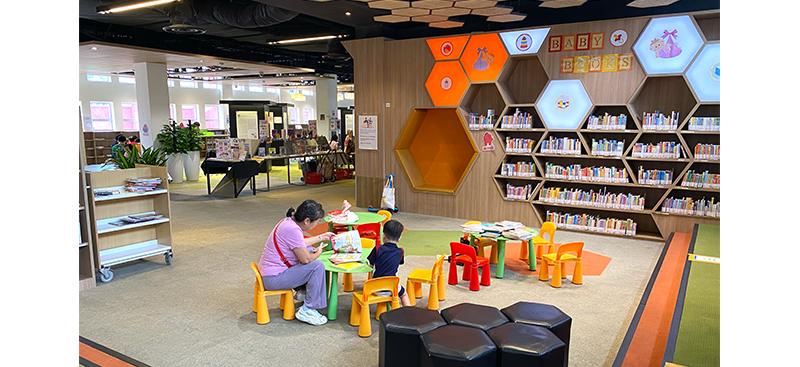
Over the years, many current staff have had stints at Toa Payoh Public Library. For example, Raneetha Rajaratnam, NLB’s current director for programmes and services, started her career as a librarian there from 1997 to 1999. “Toa Payoh [was] my first posting when I joined NLB,” she said. “I was a ‘green sponge’, excitedly absorbing everything.” Siti Komsah Sudi, who worked as a library officer at Toa Payoh Public Library from 1995 to 2023, said: “Toa Payoh Library is special to me because my own children have grown up together with the library. When they were young, they frequented the library while I was working and although they don’t visit me in the library as much now, the library reminds me of how it has grown with my kids.”31
Looking Ahead
In February 2023, it was announced that Toa Payoh Public Library would be moving to a new integrated development by 2030. To be located on a 12-hectare plot of land between Lorong 6 Toa Payoh and the Pan Island Expressway, the integrated development will house other amenities such as a polyclinic, swimming pools, indoor sports halls, fitness studios, a gymnasium and even a football stadium.32
“We look forward to working with partners and the community to build a bigger library in Toa Payoh that complements the integrated hub,” said Ng Cher Pong, NLB’s chief executive officer. “We will also find new ways to offer services that will enhance the experience of our patrons. This is in line with our LAB25 (Libraries and Archives Blueprint 2025) goal to work with partners, to evolve and innovate libraries and archives in order to better serve our patrons.”
Even as the library moves to a new home, its proximity to sports facilities will continue to reflect the library’s association with sporting heritage and serve as a reminder of its long history.33
 Rebecca Tan is a Children and Teens Librarian at Toa Payoh Public Library. She develops content and services for children and teens, and works with schools to promote a culture of reading. She was previously a Digital Heritage Librarian with the National Library Singapore.
Rebecca Tan is a Children and Teens Librarian at Toa Payoh Public Library. She develops content and services for children and teens, and works with schools to promote a culture of reading. She was previously a Digital Heritage Librarian with the National Library Singapore. Notes
-
“Jek to Open Toa Payoh Library,” Straits Times, 5 February 1974, 13. (From NewspaperSG) ↩
-
Chan Thye Seng, oral history interview by Jason Lim, 10 May 2000, transcript and MP3 audio, Reel/Disc 9 of 15, National Archives of Singapore (accession no. 002265), 103. ↩
-
Chan Thye Seng, oral history interview, 10 May 2000, Reel/Disc 9 of 15, 102. ↩
-
“Services at Library,” Straits Times, 8 February 1974, 15. (From NewspaperSG) ↩
-
Amarjeet Gill, interview, 3 March 2025. ↩
-
“Bustling Games Village Goes Silent,” New Nation, 12 September 1973, 10. (From NewspaperSG) ↩
-
“Toa Payoh Library,” Straits Times, 9 January 1973, 6; “25 Years Ago: The Biggest,” Straits Times, 5 May 1998, 41. (From NewspaperSG); National Library Board, Annual Report 1973 (Singapore: National Library Board, 1973), 9. (From National Library Online) ↩
-
Chan Thye Seng, oral history interview, 10 May 2000, Reel/Disc 10 of 15, 106. ↩
-
National Library Board, Toa Payoh Community Library (Singapore: National Library Board, 1974). (From National Library Singapore, call no. RCLOS NC3) ↩
-
Jek Yeun Thong, “Official Opening of the Toa Payoh Branch Library on Thursday, 7 Feb 74 at 7.30 PM (Delivered by Haji Sha’Ari Tadin, Senior Parliamentary Secretary to the Minister for Culture),” speech, 7 February 1974, transcript, Ministry of Culture. (From National Archives of Singapore document no. PressR19740207); Ministry of Information and the Arts, Senior Parliamentary Secretary to Ministry of Culture Sha’ari Tadin Opening Toa Payoh Public Library, 7 February 1974, photograph. (From Ministry of Information and the Arts Collection, National Archives of Singapore accession no. 7928/01/25) ↩
-
Ismail Kassim, “Making Libraries Social and Cultural Centres,” New Nation, 21 May 1974, 4. (From NewspaperSG) ↩
-
National Library Board, Community Information: Toa Payoh Community Library (Singapore: National Library Board, 1985). (From National Library Singapore, call no. RCLOS NR5) ↩
-
“Now You Can Study at 11 Public Libraries,” Straits Times, 2 November 2003, 6. (From NewspaperSG) ↩
-
“A Hundred More Chairs for Toa Payoh Library,” Straits Times, 20 December 1975, 18. (From NewspaperSG) ↩
-
“Toa Payoh Library Celebrates,” Straits Times, 16 August 1984, 14. (From NewspaperSG) ↩
-
National Library Board, Programmes: Toa Payoh Community Library (Singapore: National Library Board, 1974). (From National Library Singapore, call no. RCLOS NE7) ↩
-
Amarjeet Gill, interview, 3 March 2025. ↩
-
“Library to Close,” Straits Times, 23 November 1981, 8; “Library Re-opens,” Straits Times, 10 March 1982, 8; “Library Opens Kids’ Section,” Straits Times, 12 July 1982, 11. (From NewspaperSG) ↩
-
Cephah Tan, “Library to Install a Lift for the Handicapped,” Straits Times, 7 August 1984, 16; “$77,000 Lift for Disabled at Library,” Straits Times, 25 December 1985, 9; “Big ‘Lift’ for Handicapped at Toa Payoh Library,” Straits Times, 3 January 1986, 14. (From NewspaperSG) ↩
-
George Yeo, “Libraries of the Future to Develop Along Twin Tracks,” Straits Times, 30 March 1995, 28; “Library Board to Start Operations Next Month,” Straits Times, 19 August 1995, 31. (From NewspaperSG) ↩
-
“Changing with the Times,” Straits Times, 11 April 1997, 4. (From NewspaperSG); Hajbee Abu Bakar, interview, 3 January 2025. ↩
-
“A Day in the Community Library,” The New Paper, 22 July 1999, 24. (From NewspaperSG) ↩
-
Wendy Tan, “Facelift for Toa Payoh Library,” Straits Times, 5 May 1998, 41; Joyce Fang, “Library Sets Up Room for Elderly,” Straits Times, 28 May 1999, 75. (From NewspaperSG) ↩
-
“A Day in the Community Library”; “Treasures of the Ark, and a Place for Grandpa Too,” Straits Times, 14 June 1999, 7. (From NewspaperSG) ↩
-
Hajbee Abu Bakar, interview, 3 January 2025. ↩
-
Roy Won, interview, 20 December 2024. ↩
-
National Library Board, National Library Board Annual Report 2008/2009 (Singapore: National Library Board, 2009), https://www.nlb.gov.sg/main/-/media/NLBMedia/Documents/About-Us/Press-Room-Publication/Annual-Reports/AR-2008-09.pdf. ↩
-
Collection of anecdotes from staff in preparation for Toa Payoh Public Library’s 40th anniversary celebrations in 2014. ↩
-
“New Sports Centre, Polyclinic and Library in Toa Payoh to Be Completed by 2030,” CNA, 26 February 2023, https://www.channelnewsasia.com/singapore/toa-payoh-integrated-development-new-sports-centre-polyclinic-library-park-2030-3306471; Kimberly Kwek, New Sports Centre, Polyclinic, Library and Town Park in Toa Payoh to Be Ready by 2030,” Straits Times, 26 February 2023, updated 25 November 2024, https://www.straitstimes.com/singapore/new-sports-centre-polyclinic-library-and-town-park-in-toa-payoh-to-be-ready-by-2030. ↩
-
“Distinctively Toa Payoh!” National Library Board, 26 February 2023, https://www.nlb.gov.sg/main/about-us/press-room-and-publications/media-releases/2023/Distinctively-Toa-Payoh. ↩

